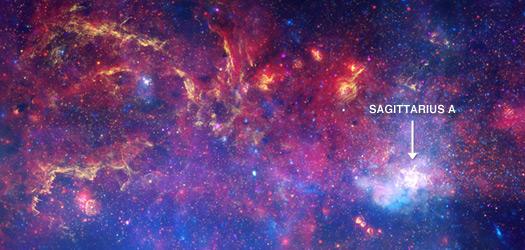
A three-color image of the central regions of the Milky Way showing the location of Sagittarius A*, the galactic center's supermassive blackhole; X-ray in blue, optical in yellow, and infrared in red. Astronomers have obtained simultaneous mulit-band observations of a bright flare from SgrA* and modeled the mult-band radiation to estimate properties of the accretion around the black hole.
The supermassive black hole at the center of our Milky Way galaxy, Sagittarius A* (“SgrA*), is by far the closest such object to us, about 27 thousand light-years away. Although it is not nearly so active or luminous as other galactic nuclei with supermassive black holes, its relative proximity makes it appear much brighter to us than other similar sources and provides astronomers with a unique opportunity to probe what happens when gas clouds or other objects get close to the “edge” of a black hole.
Sgr A* has been monitored at radio wavelengths since its discovery in the 1950's; variability was first reported in the radio in 1984. Astronomers model that on average Sgr A* is accreting material at a few hundredths of an Earth-mass per year, a relatively very low rate. Subsequent infrared, submillimeter, and X-ray observations confirmed this variability but also discovered that the object often flares, with the brightness thereby increasing by as much as a factor of one hundred in X-rays. Most of the steady emission is thought to be produced by electrons spiraling at close to the speed of light (called relativistic motion) around magnetic fields in a small region only about an astronomical unit in radius around the source, but there is no agreement on the mechanism(s) powering the flares.
CfA astronomers Giovanni Fazio, Mark Gurwell, Joe Hora, Howard Smith, and Steve Willner were members of a large consortium that in July 2019 obtained simultaneous near infrared observations with the IRAC camera on Spitzer, with the GRAVITY interferometer at the European Southern Observatory, and with NASA's Chandra and NuStar X-ray observatories (scheduled simultaneous observations with the Submillimeter Array were prevented by the Mauna Kea closure). SgrA* serendipitously underwent a major flaring event during these observations, enabling theoreticians for the first time to model a flare in considerable detail.
Relativistic electrons moving in magnetic fields emit photons by a process known as synchrotron radiation (the most conventional scenario) but there is also a second process possible in which photons (produced either by synchrotron emission or by other sources like dust emission) are scattered off the electrons and thereby acquire additional energy, becoming X-ray photons. Modeling which combination of effects was operative in the small region around SgrA* during the flaring event offers insights into the densities of the gas, the fields, and the origin of the flare’s intensity, timing, and shape. The scientists considered a variety of possibilities and concluded that the most probable scenario is the one in which the infrared flare was produced by the first process but with the X-ray flare produced by the second process. This conclusion has several implications for the activity around this supermassive black hole, including that the electron densities and magnetic fields are comparable in magnitude to those under average conditions but that sustained particle acceleration is required to maintain the observed flare. Although the models successfully match many aspects of the flare emission, the measurements are not able to constrain the detailed physics behind the particle acceleration; these are left to future research.
Reference: "Constraining Particle Acceleration in Sgr A* With Simultaneous GRAVITY, Spitzer, NuSTAR and Chandra Observations," GRAVITY Collaboration: R. Abuter et al. Astronomy & Astrophysics.
Related News
Runaway Stars Reveal Hidden Black Hole In Milky Way’s Nearest Neighbor
NASA's Hubble, Chandra Find Supermassive Black Hole Duo
Event Horizon Telescope Makes Highest-Resolution Black Hole Detections from Earth
CfA Celebrates 25 Years with the Chandra X-ray Observatory
CfA Astronomers Help Find Most Distant Galaxy Using James Webb Space Telescope
Astronomers Unveil Strong Magnetic Fields Spiraling at the Edge of Milky Way’s Central Black Hole
Black Hole Fashions Stellar Beads on a String
M87* One Year Later: Proof of a Persistent Black Hole Shadow
Unexpectedly Massive Black Holes Dominate Small Galaxies in the Distant Universe
Unveiling Black Hole Spins Using Polarized Radio Glasses
Projects
AstroAI
DASCH (Digital Access to a Sky Century @ Harvard)
For that reason, the DASCH (Digital Access to a Sky Century @ Harvard) team are working to digitize the plates for digital storage and analysis. The process can also lead to new discoveries in old images, particularly of events that change over time, such as variable stars, novas, or black hole flares.
GMACS
For Scientists
Sensing the Dynamic Universe
SDU Website